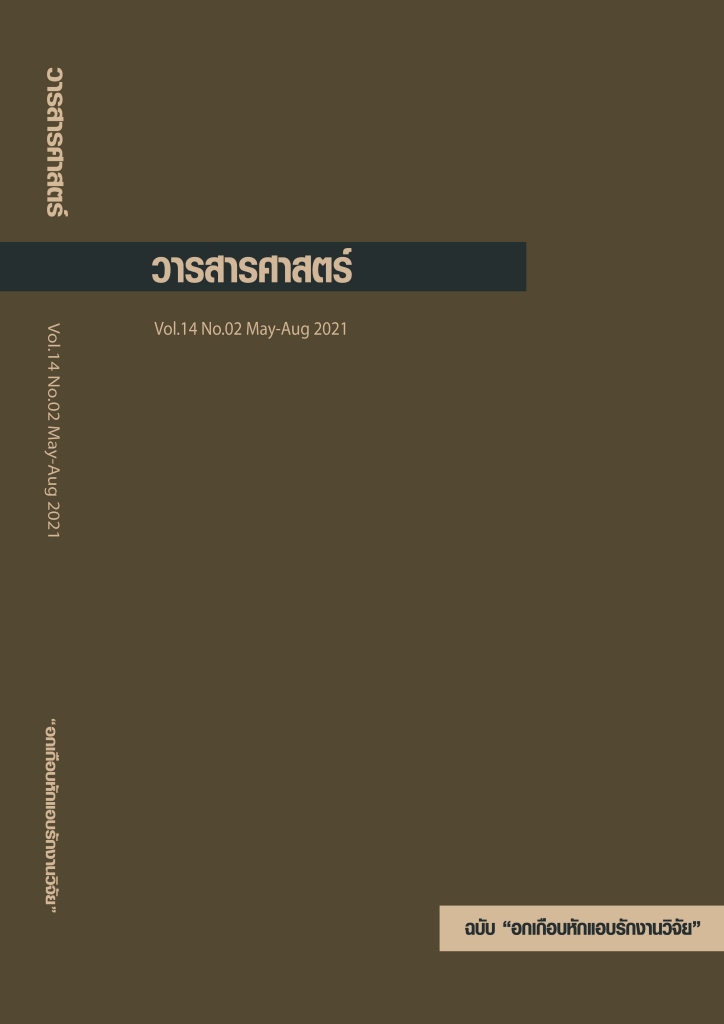Representing Emotional Lives of Precarious Japan: Jun Ichikawa’s Tony Takitani
คำสำคัญ:
ภาษาภาพยนตร์, ภาพยนตร์ญี่ปุ่น, จุน อิชิกาวะ, การสื่อสารอารมณ์, ช่วงเวลาแห่งความไม่มั่นคงในชีวิตบทคัดย่อ
บทความนี้มีวัตถุประสงค์เพื่อวิเคราะห์การสะท้อนภาพประวัติศาสตร์ หลังสงครามของญี่ปุ่นโดยเฉพาะช่วงเวลาแห่งความไม่มั่นคงในชีวิตของยุคปัจจุบัน ผ่านภาพยนตร์เรื่อง Tony Takitani โดยนอกเหนือจากการถ่ายทอดเรื่องราวผ่าน คำบรรยายและดนตรีประกอบแบบภาพยนตร์ทั่วไปแล้ว Jun Ichikawa ผู้กำกับ ภาพยนตร์เรื่องนี้และเพื่อนร่วมงานของเขายังมีการใช้เทคนิคที่มีประสิทธิภาพ เด่นชัด 2 ประการ คือ (1) ภาพแบบชัดตื้นและการใช้เสียงประกอบ เพื่อแสดง ให้เห็นถึงการแยกตัวละครออกจากสังคมและ (2) การผสมผสานระหว่างการ ตัดต่อทิศทางการเคลื่อนไหวของจอภาพกับการเคลื่อนไหวของตัวละคร ทั้งนี้ เพื่อแสดงให้เห็นว่า ตัวละครต่างๆ มีประสบการณ์ทางประวัติศาสตร์ที่แตกต่าง กันอย่างไร โดยมีการเปรียบเทียบตัวละครสองตัวละครคือ ตัวละครมีชื่อว่าโทนี่ ผู้ผ่านประสบการณ์ความรู้สึกทรมานจากการสูญเสีย กับตัวละครที่มีชื่อว่าฮิซาโกะ ซึ่งมองโลกในแง่ดี อิชิกาวะได้แสดงให้เห็นในช่วงเวลาแห่งความไม่มั่นคง ซึ่งเป็น ช่วงเวลาสำคัญของประวัติศาสตร์หลังสงครามของญี่ปุ่นนั้น ไม่ใช่มีเพียงแง่มุมของ โศกนาฏกรรมเท่านั้น แต่ทว่ายังมีอีกหลายแง่มุม
เอกสารอ้างอิง
Amamiya, K. (2007), Purekariāto: Dejitaru hiyatoi sedai no fuan na ikikata [Precariat: ThePrecarious Life of Digital Day Labor Generation], Tokyo: Yōsensha.
Baudrillard, J. (1998), The Consumer Society: Myths and Structures, London: Sage.
Barnett, D. (2014), Brecht in Practice: Theatre, Theory and Performance, London:Bloomsbury.
Denzin, N. (1984), On Understanding Emotion, San Francisco: Jossey-Bass.
Giannetti, L. (2014), Understanding Movies, Boston: Pearson Education.
Giddens, A. (1991), Modernity and Self-identity: Self and Society in the Late Modern Age,California: Stanford University Press.
Gould, D. (2009), Moving Politics: Emotion and ACT UP’s Fight against AIDS, Chicago:University of Chicago Press.
Hochschild, A. (1983), The Managed Heart: Commercialization of Human Feeling, Berkeley,CA: University of California Press.
Holbrook, M. and Hirschman, E. (1982), “The Experiential Aspects of Consumption: Consumer Fantasies, Feelings, and Fun”, Journal of Consumer Research, 9(2): 132-140.
Kawade Shobō Shinsha (2009), Ichikawa Jun, Tokyo: Kawade Shobō Shinsha.
Lyttleton, C. (2004), “Fleeing the Fire: Transformation and Gendered Belonging in Thai HIV/AIDS Support Groups”, Medical Anthropology, 23(1): 1-40.
Marcus, G. (2000), “Emotions in Politics”, Annual Review of Political Science, 3(1): 221-250.
Mita, M. (1992), Social Psychology of Modern Japan, translated by S. Suloway, London: Kegan Paul International.
Mori, H. (2019), “‘Tony Takitani’ no honbunkaitei (6) shōto/rongu ryōbājon no tōjōjosei nikansuru byōsha (1) [Text Creative of Tony Takitani (Vol.6) Difference in Depiction of Short and Long Versions of Women (1)]”, Hyogengaku (5): 19-26.
Murakami, H. (1999), “Tony Takitani”, in Murakami, H. (ed.), Rekishinton no yūrei. [Lexington Ghosts], Tokyo: Bungei Shunju.
________. (2006), “Tony Takitani”, in Rubin, T. (trans.), Blind Willow, Sleeping Woman [E-reader version], New York: Vintage.
Neuman, W. et al. (2007)., The Affect Effect: Dynamics of Emotion in Political Thinking and Behavior, University of Chicago Press.
Ochiai, E. (1994), 21-seiki kazoku e [Toward the Twenty First Century Family], Tokyo: Yūhikaku.
Pawlett, W. (2007), Jean Baudrillard: Against Banality, London: Routledge.
Reddy, W. (2001), The Navigation of Feeling: Framework for a History of Emotions, Cambridge: Cambridge University Press.
Tsing, A. (2015), The Mushroom at the End of the World: On the Possibility of Life in Capitalist Ruins, New Jersey: Princeton University Press.
Yoshimi, S. (2009), Posuto sengo shakai: sirizu nihon kingendaishi 9 [The Postwar Society: Japanese Modern History Series Volume 9], Tokyo: Iwanami.
Williams, R. (1977), Marxism and Literature, Oxford: Oxford University Press.
________. (2013), The Long Revolution, London: Chatto & Windus.
Bowman, D. (2007), Tony Takitani, Midnight Eye, retrieved 27 July 2020 from http://www.midnighteye.com/reviews/tony-takitani/
Dargis, M. (2005), He’s an Isolated Fellow; She’s Addicted to Shopping, retrieved 27 July 2020 from http://www.nytimes.com/2005/07/29/movies/hes-an-isolated-fellow-shes-addicted-to-shopping.html
Ichikawa Jun Office (2009), Biography, retrieved 2 August 2020 from http://www.ichikawa-jun.com/bio.html
Ichikawa, J. (Director) (2005), Tony Takitani [DVD], Japan: Geneon Entertainment.
Muramatsu, M. (Director) (2005), Hareta ie [Sunny Home] [DVD], Japan: Geneon Entertainment.
Ozu, Y. (Director) (1953/2013), Tokyo Monogatari [Tokyo Story] [DVD], Japan: Shochiku.
Sakamoto, R. (2007), Tony Takitani Original Soundtracks [CD], Japan: Commons.








